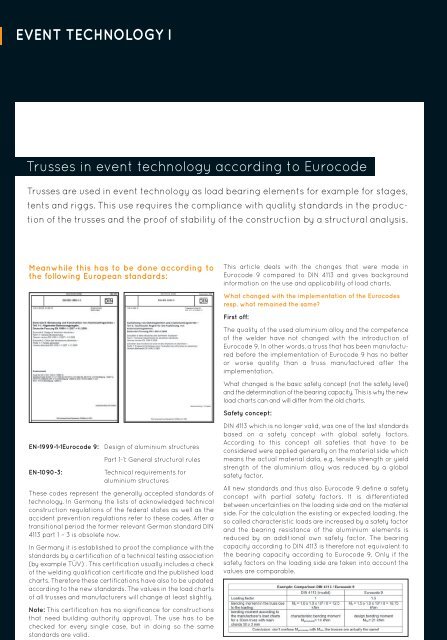o_19jdnovcg1eh21852116govv1lgra.pdf
Sie wollen auch ein ePaper? Erhöhen Sie die Reichweite Ihrer Titel.
YUMPU macht aus Druck-PDFs automatisch weboptimierte ePaper, die Google liebt.
EVENT TECHNOLOGY I<br />
Trusses in event technology according to Eurocode<br />
Trusses are used in event technology as load bearing elements for example for stages,<br />
tents and riggs. This use requires the compliance with quality standards in the production<br />
of the trusses and the proof of stability of the construction by a structural analysis.<br />
Meanwhile this has to be done according to<br />
the following European standards:<br />
EN-1999-1-1Eurocode 9:<br />
EN-1090-3:<br />
Design of aluminium structures<br />
Part 1-1: General structural rules<br />
Technical requirements for<br />
aluminium structures<br />
These codes represent the generally accepted standards of<br />
technology. In Germany the lists of acknowledged technical<br />
construction regulations of the federal states as well as the<br />
accident prevention regulations refer to these codes. After a<br />
transitional period the former relevant German standard DIN<br />
4113 part 1 – 3 is obsolete now.<br />
In Germany it is established to proof the compliance with the<br />
standards by a certification of a technical testing association<br />
(by example TÜV) . This certification usually includes a check<br />
of the welding qualification certificate and the published load<br />
charts. Therefore these certifications have also to be updated<br />
according to the new standards. The values in the load charts<br />
of all trusses and manufacturers will change at least slightly.<br />
Note: This certification has no significance for constructions<br />
that need building authority approval. The use has to be<br />
checked for every single case, but in doing so the same<br />
standards are valid.<br />
This article deals with the changes that were made in<br />
Eurocode 9 compared to DIN 4113 and gives background<br />
information on the use and applicability of load charts.<br />
What changed with the implementation of the Eurocodes<br />
resp. what remained the same?<br />
First off:<br />
The quality of the used aluminium alloy and the competence<br />
of the welder have not changed with the introduction of<br />
Eurocode 9. In other words, a truss that has been manufactured<br />
before the implementation of Eurocode 9 has no better<br />
or worse quality than a truss manufactured after the<br />
implementation.<br />
What changed is the basic safety concept (not the safety level)<br />
and the determination of the bearing capacity. This is why the new<br />
load charts can and will differ from the old charts.<br />
Safety concept:<br />
DIN 4113 which is no longer valid, was one of the last standards<br />
based on a safety concept with global safety factors.<br />
According to this concept all safeties that have to be<br />
considered were applied generally on the material side which<br />
means the actual material data, e.g. tensile strength or yield<br />
strength of the aluminium alloy was reduced by a global<br />
safety factor.<br />
All new standards and thus also Eurocode 9 define a safety<br />
concept with partial safety factors. It is differentiated<br />
between uncertainties on the loading side and on the material<br />
side. For the calculation the existing or expected loading, the<br />
so called characteristic loads are increased by a safety factor<br />
and the bearing resistance of the aluminium elements is<br />
reduced by an additional own safety factor. The bearing<br />
capacity according to DIN 4113 is therefore not equivalent to<br />
the bearing capacity according to Eurocode 9. Only if the<br />
safety factors on the loading side are taken into account the<br />
values are comparable.<br />
198


